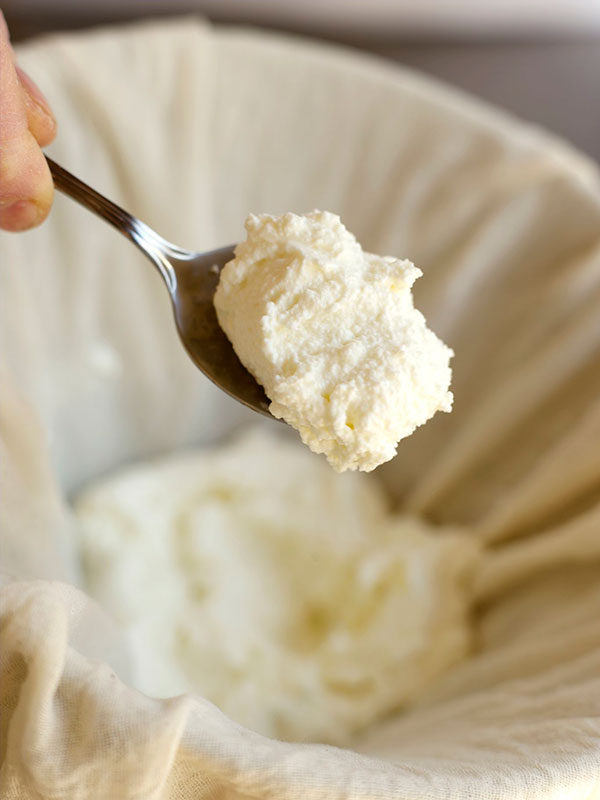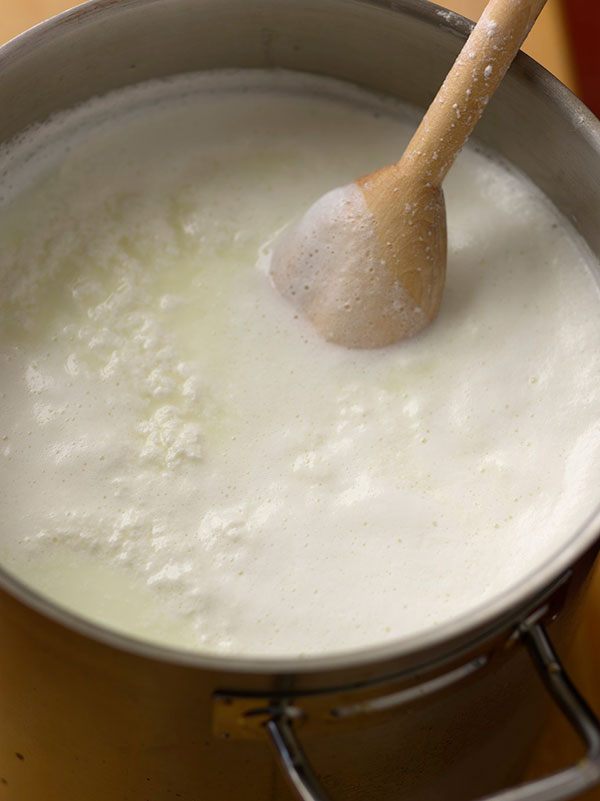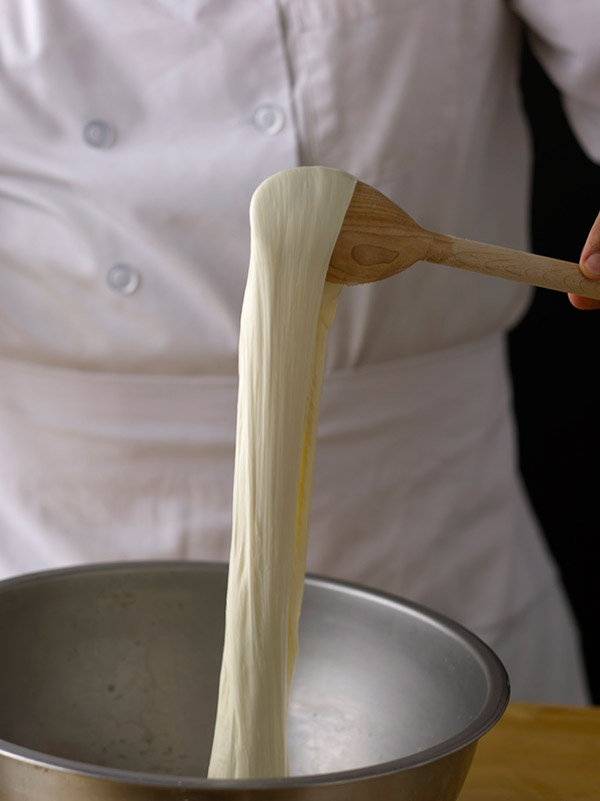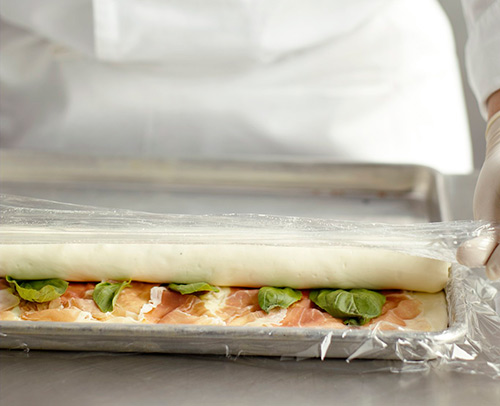There are few greater joys than a freshly made cheese, like a mozzarella still warm from its bath. And while there are many styles of cheese available on the market today, some of which take a long time to make or require special equipment or conditions, many can be made with either everyday kitchen ingredients or items that are readily available from the ever-expanding online marketplace.
Cheese 101
On its most basic level, cheese is simply preserved milk or, as editor and essayist Clifton Fadiman described it, “milk’s leap towards immortality.” To “preserve the milk,” one must lower the water activity, thereby controlling the bacteria that cause spoilage. Ironically, cheese makers achieve this by using other, beneficial bacteria. The same effect is also achieved by using acid.

Whole milk is made up of about 3% protein, 4% fat, 4% sugar (lactose), and 89% water. Acids have the effect of denaturing and coagulating proteins; when added to milk, the proteins denature (unwind) and coagulate (bond together), forming curds. Acid may come in the form of vinegar, for ricotta cheese; lemon juice, for lemon cheese; or from other sources. Heat accelerates the acid reaction, and the type of acid used will give the cheese its distinctive flavor and aroma.
Bacterial cultures are also used to make fresh cheeses and lend specific flavors and aromas to the finished product. These cultures digest the sugar in the milk and give off carbon dioxide and lactic acid as by-products. The lactic acid then causes the same denaturing and coagulating of proteins. Bacterial cultures used for making fresh cheeses are available from online retailers or certain specialty or health markets.
After treating with heat and acid, the curds (coagulated proteins) are separated from the whey (water) by either simply straining or by pressing the cheese in a mold. The longer the curds are strained or pressed, the drier the cheese will be. For example, fresh ricotta is a soft wet cheese, while ricotta salata is drier.
Heavy cream can be substituted for or used in conjunction with milk. Because heavy cream has a different fat content (about 40%), it reacts differently to acid. The proteins in cream still denature and coagulate, but they coagulate into smaller, creamier curds. Mascarpone cheese, made with heavy cream, is thicker and creamier than ricotta cheese, made with whole milk.
Cheese-Making Equipment

Producing fresh cheeses does not require any special equipment. You can use standard stainless-steel pots, bowls, and spoons. Digital probe thermometers come in handy for heating milk or cream to the proper temperatures. You may decide to keep a separate fine mesh or conical strainer specifically for cheese making, as well as some cheesecloth.
A Word About Sanitation
In the case of fresh cheeses, cleanliness is paramount. Contaminated equipment can introduce unwanted bacterial cultures into your product, resulting in a failed cheese at best, or food borne illness at worst. When preparing fresh cheeses, be sure that all equipment— pots, bowls, spoons, strainers, thermometers, etc.—has been properly cleaned and sanitized.
Fresh Cheese Fundamentals
Begin by gathering all ingredients and equipment. Be sure that the equipment has been properly cleaned and sanitized, and the ingredients are fresh and of good quality. Heat the milk to the temperature specified in your recipe, and add the acid or bacterial culture. Allow the mixture to stand until curds form. Strain the mixture through cheesecloth if necessary. Flavor fresh cheeses with minced herbs or spices, dried fruit or fruit zest, or any other desired sweet or savory combination. Store fresh cheeses in clean plastic containers with tight-fitting lids. Fresh cheeses should be used in three to five days and must be held under refrigeration, below 40°F. Fresh cheeses do not freeze well.
Because they are fairly easy and quick to produce, make only what you need for a short time.
Making Fresh Mozzarella

One type of cheese that is easy to make at home is pasta filata or spun curd cheese. An example is fresh mozzarella, which begins with mozzarella curd, readily available from many retailers. The curd is commercially made by treating milk with an enzyme called rennet, a substance found in the lining of a calf’s stomach that causes the proteins in milk to gel. This gel-like mass is soft and mealy in the raw state, but when cooked and stretched into fresh mozzarella, it becomes pleasantly chewy and stringy.
Mozzarella curd is transformed into cheese by heating the curd, which causes the proteins to denature. These denatured proteins bond together in long chains and become stretchy, like dough. The stretchy cheese is worked and formed into a number of different shapes, each with descriptive names. Ciliegini comes from the Italian word for cherry, and suggests a cherry-size cheese. Bocconcini, from the Italian word for mouthful, describes a more bite-sized cheese.
 A fabulous application of fresh mozzarella is in a roulade. Prepare the cheese as in the recipe, but rather than shape it into smaller cheeses, roll a portion out flat on a work table. Lay in some sliced prosciutto, basil leaves, and cracked black pepper. Roll the cheese up tightly and secure with plastic wrap or cheesecloth. When the cheese cools to room temperature it will be sliceable. Use the sliced roulades on a crostini as an hors d’oeuvre or amuse bouche, or put platters of sliced cheese roulades on an antipasto plate. Mozzarella cheese roulades can also be made with an assortment of fillings including pesto and tapenade.
A fabulous application of fresh mozzarella is in a roulade. Prepare the cheese as in the recipe, but rather than shape it into smaller cheeses, roll a portion out flat on a work table. Lay in some sliced prosciutto, basil leaves, and cracked black pepper. Roll the cheese up tightly and secure with plastic wrap or cheesecloth. When the cheese cools to room temperature it will be sliceable. Use the sliced roulades on a crostini as an hors d’oeuvre or amuse bouche, or put platters of sliced cheese roulades on an antipasto plate. Mozzarella cheese roulades can also be made with an assortment of fillings including pesto and tapenade.


